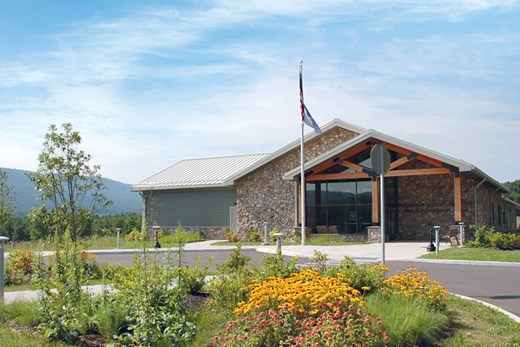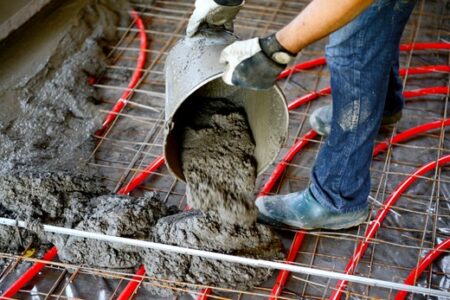Solution provider

The global climate crisis caused by carbon emissions is a key threat to society and our planet. Danfoss’ energy-efficient and climate-friendly solutions enable a cost-effective green transition.
Case
District energy


The global climate crisis caused by carbon emissions is a key threat to society and our planet. Danfoss’ energy-efficient and climate-friendly solutions enable a cost-effective green transition.
Add the case to your visit request and let us know that you are interested in visiting Denmark
Department of Conservation and Natural Resources conscientiously chooses low-energy, high-comfort solutions to heat the new Resource Management Center in Pennsylvania’s Buchanan State Forest district.
There are 2.2 million acres of scenic forest in the state of Pennsylvania, teeming with local wildlife and valuable resources. These resources — such as pure water, sustainable timber and natural gas — need to be managed, preserved and maintained both for the habitats of plants and animals, as well as opportunities for outdoor recreation. Roughly 70,000 of those acres fall within the boundaries of Buchanan State Forest, which is named after the 15th President of the United States James Buchanan.
Some forest management practices are evident, such as harvesting timber, installing deer enclosure fences, implementing prescribed fires and spraying for gypsy moths. Others, while less noticeable, are also critical, such as buffering streams from timber harvesting or protecting areas of land to either conserve its wild character or shield a rare plant community. These tasks, carried out by Buchanan Forest’s rangers, foresters and entomologists, all need to operate out of a central hub.
But, faced with challenges in its previous office space that left forest district employees scattered in various buildings, separated from their daily work in the woodlands and with little room to grow, the state’s Bureau of Forestry decided to construct a brand-new Resource Management Center in McConnellsburg, Pennsylvania. The new center, built in 2016, comprises two structures: a 9,700-square-foot main building, which provides administrative space, and a 6,000-square-foot storage building that houses forest equipment and supplies.

Conscientious construction
The Bureau of Forestry worked with the Department of Conservation and Natural Resources (DCNR) on the construction. With the Pennsylvania DCNR’s vision to conserve and maintain the state’s natural resources, it comes as no surprise that 21 of its buildings have been constructed under the U.S. Green Building Council’s (USGBC) Leadership in Energy and Environmental Design (LEED) Green Building Rating System. The Resource Management Center project was no different.
When designing a building with the specific intent to pursue LEED certification, every aspect of the construction process — from the building design and the demolition process to the materials used and the long-term efficiency of the building — must be carefully considered and evaluated. Yet the extra effort and planning always pays off in the end.
Finding a sustainable heating solution
Sourcing sustainable low-energy, high-comfort solutions was the standard for every aspect of the new Resource Development Center, including the heating system.
“The main heat source for both buildings is radiant slab heat, which is PEX tubing in concrete,” said Jason Adams, a mechanical engineer with the Pennsylvania DCNR. “It is the most comfortable heat for that type of space, specifically an office.”
To bring his hydronic heating solution and design to life, Adams engaged ATI Systems — a local full-service distributor for hydronic and HVACR products. Carl Longenecker, ATI Systems’ founder, worked directly with Adams to source the various products needed to build the system.
Hydronic, or radiant, heat is achieved by running hot water through loops of plastic tubes in the concrete floor, allowing heat to radiate evenly across the entire floor surface. Pumps work to constantly circulate newly heated water into the plastic tubing, while the concrete absorbs the heat, and the cooler water is returned to the boiler to begin its journey again.
Hydronic heat ranks high on energy efficiency. It is more effective than conventional forced air systems because it utilizes conduction and radiation to heat the floor and other objects in the space rather than heating the air, allowing occupants to feel comfortable while optimizing energy performance.

Incorporating local resources
To further improve energy efficiency and reduce the system’s environmental impact, DCNR opted to design a hydronic system that used a biomass boiler in lieu of a gas- or oil-fired boiler. The boiler, which utilizes wood pellets as fuel, has a rated heat output of 102,000-341,000 BTU/hour and can modulate its output based on the building’s heating demand.
“There used to be a gap in boiler sizes between residential sizes, with about 150,000 BTUs, and commercial boilers, which ran from 500,000 BTUs and beyond. But we were able to find an option for wood pellet boilers that was in the higher range of the residential market but the lower end of the commercial — meeting our needs perfectly,” said Adams. “Furthermore, this boiler is ASME rated, which is huge. It allows us to have a pressurized system throughout rather than manipulating the water pressure to have zero psi when passing through the boiler, which is what we had to do on previous hydronic heating projects.”
The Bureau of Forestry was interested in incorporating innovative elements that were better for the environment and the community, so they utilize locally-produced wood pellets as fuel.
“Regardless of whether a tree that has fallen decays on the forest floor or is burned for energy, the same amount of carbon is released into the atmosphere, making wood pellets carbon-neutral,” explained Longenecker. “The key to truly being environmentally friendly when burning a fuel like this is to have complete combustion. These boilers essentially produce zero smoke — just a little bit of water vapor and fly ash.”
The biomass boiler is connected to a 750-gallon insulated buffer tank, which Longenecker explained is because “the boiler itself is so efficient that it cannot tolerate being cycled on and off like a traditional fossil fuel boiler.” Biomass systems need time to ramp up and begin burning the fuel, which doesn’t coincide with varying day-to-day temperature needs. “On various days there are different loads. Some days you may not even need much heating at all. So in order to make it work between a system that wants to run at a relatively high output and a building with flexible needs, we utilize an intermediary tank between the two.”
While the boiler is running at a consistent pace, the temperature to which it will heat the buffer tank is determined by an outdoor reset controller, allowing the outdoor temperature to determine the temperature of the tank, avoiding unnecessary heating and improving overall efficiency.
Controlling the in-floor heating system’s supply water temperature
The outdoor reset also determines the temperature the water must be at any given point before it can circulate through the roughly 15,000 feet of plastic tubing laid throughout the center’s floor.
“We call it temperature curve,” explains William Boss, sales manager at Danfoss. “The cooler it is outside, the warmer you want the floor to be. Since the system isn’t being turned on and off, the water temperature in the concrete slab has to be continuously adjusted in real time.”
To achieve a responsive water temperature, the hydronic system relies on ESBE VRG130 three-way valves and ESBE ARA600 motorized valve actuators from Danfoss. The VRG three-way valves take two streams of water — one at a higher temperature from the buffer tank and the cooler water returning from the tubing in the floor — and mixes them at the right ratio to create the optimal fluid temperature according to the ARA600 motorized valve actuator, which is electronically connected to the outdoor reset feature.
“The outdoor reset and Danfoss valves are critical for creating the correct water temperature, so the space isn’t over- or under-heated,” Longenecker said. “Concrete takes so long to absorb and radiate the heat from the system. So, if the temperature of the water is off, it will take too long to manually readjust. With almost 16,000 total square feet of concrete to heat and almost 1,000 gallons of water in the plastic tubing, the temperature must be correct from the very beginning.”
“The quality of these valves is amazing, and the machining of the brass is second to none,” said Boss. The valves are made of corrosion-resistant brass for the highest performance and longevity, and offer multiple benefits, including precise control, easy installation, optimal comfort, and tangible energy savings.
“ESBE valves are engineered to provide highly accurate flow control for precise control over the mixed water temperature — which can directly translate into energy efficiency,” Boss continued. “We offer the valves in sizes from 1/2-inch to 6-inches that comply with all standard control signals, letting us put together the right package to address any application.”
Longenecker has a longstanding relationship with Danfoss, and knew they’d be an ideal partner for this project. “When we are designing hydronic projects, whether biomass or conventional, it is always our goal to provide the building owner with the best performing and longest lasting system possible. Over the years we have found that Danfoss not only offers a world-class array of products to fit the needs of almost any project, but also provides an exceptional value in terms of quality and durability,” he said. “Danfoss is a world leader in HVAC solutions. They dominate the heating and ventilation market with incredibly great products.”

Warmer floors tackle winter weather
Along with being an ideal heating solution for an office building, there are also major benefits to using the same hydronic heating system in the center’s maintenance garage.
“Bureau of Forestry staff often need to plow forest roads in the middle of winter,” Longenecker mused. “When the vehicles return to the garage, they’re loaded up with snow. But because the floor — not the air — of the new center can now be heated to 80 degrees, the snow falls off the truck and evaporates quickly off the floor, maintaining a dry and safe environment for the employees.”
The ceilings in these types of buildings are so high that, if using a conventional heating system, the temperature may have to reach 90 degrees at the ceiling to only get to 65 degrees at the floor. With the hydronic heating system, however, the heat source is physically located in the right space to fully utilize the heat being generated.
Running in the background
Resource Management Center staff moved into the new facility in January 2017. “This was our first [partial]heating season, and everything has been working well,” said Adams. “According to the maintenance staff at the district, the system provides a nice, comfortable heat and they’ve had no issues with the boiler.” Thanks to high-quality and reliable technology provided by Danfoss, the hydronic heating system can perform consistently, effectively and efficiently.
Buchanan District Forester James Smith agreed. “The hydronic floor system is quiet and clean, as it doesn’t distribute dust particles around the building like a traditional heating system. Most importantly, the heat is uniformly distributed throughout the building. It has exceeded our expectations,” he said.
Although the heating system works silently behind the scenes, the energy efficiency speaks for itself. The district staff reported burning 20 tons of wood pellets to heat both buildings, which converts to 15.2 BTU/hour per square foot.
“The hydronic heating solution is a great complement to our overall focus on sustainability,” said Adams. Working toward LEED certification will bring many beneficial results for the center in the long run — occupants are comfortable and focused, while the building owners, the citizens of Pennsylvania, save money on the cost to operate the center.
The Resource Management Center is currently pursuing LEED Silver Certification.